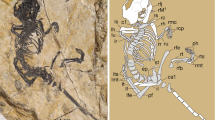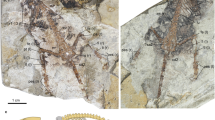Abstract
The transference of post-dentary jaw elements to the cranium of mammals as auditory ossicles is one of the central topics in evolutionary biology of vertebrates. Homologies of these bones among jawed vertebrates have long been demonstrated by developmental studies; but fossils illuminating this critical transference are sparse and often ambiguous. Here we report the first unambiguous ectotympanic (angular), malleus (articular and prearticular) and incus (quadrate) of an Early Cretaceous eutriconodont mammal from the Jehol Biota, Liaoning, China. The ectotympanic and malleus have lost their direct contact with the dentary bone but still connect the ossified Meckel’s cartilage (OMC); we hypothesize that the OMC serves as a stabilizing mechanism bridging the dentary and the detached ossicles during mammalian evolution. This transitional mammalian middle ear narrows the morphological gap between the mandibular middle ear in basal mammaliaforms and the definitive mammalian middle ear (DMME) of extant mammals; it reveals complex changes contributing to the detachment of ear ossicles during mammalian evolution.
This is a preview of subscription content, access via your institution
Access options
Subscribe to this journal
Receive 51 print issues and online access
$199.00 per year
only $3.90 per issue
Buy this article
- Purchase on Springer Link
- Instant access to full article PDF
Prices may be subject to local taxes which are calculated during checkout




Similar content being viewed by others
References
Hopson, J. A. The origin of the mammalian middle ear. Am. Zool. 6, 437–450 (1966)
Allin, E. F. Evolution of the mammalian middle ear. J. Morphol. 147, 403–438 (1975)
Maier, W. Phylogeny and ontogeny of mammalian middle ear structures. Neth. J. Zool. 40, 55–75 (1990)
Allin, E. F. & Hopson, J. A. in The Evolutionary Biology of Hearing (eds Webster, D. B., Fay, R. R. & Popper, A. N.) 587–614 (Springer, 1992)
Clack, J. A. & Allin, E. F. in Evolution of the Vertebrate Auditory System (eds Manley, G. A., Popper, A. N. & Fay, R. R. ) 128–163 (Springer, 2004)
Lillegraven, J. A. & Krusat, G. Cranio-mandibular anatomy of Haldanodon exspectatus (Docodonta; Mammalia) from the Late Jurassic of Portugal and its implications to the evolution of mammalian characters. Contrib. Geol. 28, 39–138 (1991)
Reichert, C. Über die Visceralbogen der Wirbeltiere im Allgemeinen und deren Metamorphosen bei den Vögeln und Säugetieren. Arch. Anat. Physiol. Medizin 1837, 120–222 (1837)
Gaupp, E. Die Reichertsche Theorie (Hammer-, Amboss- und Kieferfrage). Arch. Anat. Entwick. 1912, 1–416 (1913)
Goodrich, E. S. Studies on the Structure and Development of Vertebrates (Macmillan, 1930)
Kermack, K. A., Mussett, F. & Rigney, H. W. The lower jaw of Morganucodon . Zool. J. Linn. Soc. 53, 87–175 (1973)
Kermack, K. A., Mussett, F. & Rigney, H. W. The skull of Morganucodon . Zool. J. Linn. Soc. 71, 1–158 (1981)
Kielan-Jaworowska, Z., Cifelli, R. L. & Luo, Z.-X. Mammals from the Age of Dinosaurs—Origins, Evolution, and Structure (Columbia Univ. Press, 2004)
Zeller, U. Die Entwicklung und Morphologie des Schädels von Ornithorhynchus anatinus (Mammalia: Prototheria: Monotremata). Abhandl. Senckenberg. Natur. Gesell. 545, 1–188 (1989)
Zeller, U. in Mammal Phylogeny Vol. 1 (eds Szalay, F. S., Novacek, M. J. & McKenna, M. C. ) 95–107 (Springer, 1993)
Mallo, M. Formation of the middle ear: recent progress on the developmental and molecular mechanisms. Dev. Biol. 231, 410–419 (2001)
Wang, Y.-Q., Hu, Y.-M., Meng, J. & Li, C.-K. An ossified Meckel’s cartilage in two Cretaceous mammals and origin of the mammalian middle ear. Science 294, 357–361 (2001)
Meng, J. Hu, Y.-M., Wang, Y.-Q. & Li, C.-K. The ossified Meckel’s cartilage and internal groove in Mesozoic mammaliaforms: implications to origin of the definitive mammalian middle ear. Zool. J. Linn. Soc. 138, 431–448 (2003)
Luo, Z.-X., Chen, P.-J., Li, G. & Chen, M. A new eutriconodont mammal and evolutionary development in early mammals. Nature 446, 288–293 (2007)
Takechi, M. & Kuratani, S. History of studies on mammalian middle ear evolution: a comparative morphological and developmental biology perspective. J. Exp. Zool. B 314, 1–17 (2010)
Rowe, T. B. Coevolution of the mammalian middle ear and neocortex. Science 273, 651–654 (1996)
He, H.-Y. et al. Timing of the Jiufotang Formation (Jehol Group) in Liaoning, northeastern China, and its implications. Geophys. Res. Lett. 31, L12605 (2004)
Ji, Q., Luo, Z.-X. & Ji, S.-A. A Chinese triconodont mammal and mosaic evolution of the mammalian skeleton. Nature 398, 326–330 (1999)
Li Li, C.-K., Hu, Y.-M., Wang, Y.-Q. & Meng, J. A new species of Gobiconodon (Triconodonta, Mammalia) and its implication for the age of Jehol Biota. Chin. Sci. Bull. 48, 1129–1134 (2003)
Meng, J., Hu, Y.-M., Wang, Y.-Q. & Li, C.-K. A new gobiconodont species (Mammalia) from the Early Cretaceous Yixian Formation of Liaoning, China. Vert. PalAsiatica 43, 1–10 (2005)
Li, J.-L., Wang, Y., Wang, Y.-Q. & Li, C. K. A new family of primitive mammal from the Mesozoic of western Liaoning, China. Chin. Sci. Bull. 45, 2545–2549 (2000)
Hu, Y.-M., Meng, J., Li, C.-K. & Wang, Y.-Q. Large Mesozoic mammals fed on young dinosaurs. Nature 433, 149–153 (2005)
Ji, Q., Luo, Z.-X., Zhang, X., Yuan, C.-X. & Xu, L. Evolutionary development of the middle ear in Mesozoic therian mammals. Science 326, 278–281 (2009)
McClain, J. A. The development of the auditory ossicles of the opossum (Didelphys virginiana). J. Morphol. 64, 211–265 (1939)
Filan, S. L. Development of the middle ear region in Monodelphis domestica (Marsupialia, Didelphidae): marsupial solutions to an early birth. J. Zool. 225, 577–588 (1991)
Clark, C. T. & Smith, K. K. Cranial osteogenesis in Monodelphis domestica (Didelphidae) and Macropus eugenii (Macropodidae). J. Morphol. 215, 119–145 (1993)
Sánchez-Villagra, M. R., Gemballa, S., Nummela, S., Smith, K. K. & Maier, W. Ontogenetic and phylogenetic transformations of the ear ossicles in marsupial mammals. J. Morphol. 251, 219–238 (2002)
Meng, J. & Wyss, A. R. Monotreme affinities and low-frequency hearing suggested by multituberculate ear. Nature 377, 141–144 (1995)
Fleischer, G. Studien am Skelett des Gehörorgans der Säugetiere, einschliesslich des Menschen. Säugetierk. Mitt. 21, 131–239 (1973)
Fleischer, G. Evolutionary principles of the mammalian middle ear. Adv. Anat. Embryol. Cell Biol. 55, 1–70 (1978)
Henson, O. W. Comparative anatomy of the middle ear. Handbook of Sensory Physiology: The Auditory System Vol. 5, Pt 1 (eds Keidel, W. D. & Neff, W. D. ) 39–110 (Springer, 1974)
Barghusen, H. R. in The Ecology and Biology of Mammalian-like Reptiles (eds Hotton III N., MacLean, P. D., Roth, J. J. & Roth, E. C. ) 253–262 (Smithsonian Institution Press, 1986)
Crompton, A. W. in Studies in Vertebrate Evolution (eds Joysey, K. A. & Kemp, T. S. ) 231–251 (Oliver & Boyd, 1972)
Bensley, B. A. On the identification of Meckelian and mylohyoid grooves in the jaws of Mesozoic and Recent Mammalia. Univ. Toronto Stud. Biol. Ser. 3, 75–81 (1902)
Krebs, B. Evolution of the mandible and lower dentition in dryolestids (Pantotheria, Mammalia). Zool. J. Linn. Soc. 50, (Suppl. 1)89–102 (1971)
Rougier, G. W., Wible, J. R. & Novacek, M. J. Middle-ear ossicles of the multituberculate Kryptobaatar from the Mongolian Late Cretaceous: implications for mammaliamorph relationships and the evolution of the auditory apparatus. Am. Mus. Novit. 3187, 1–43 (1996)
Allin, E. F. in The Ecology and Biology of Mammal-like Reptiles (eds Hotton, N., MacLean, P. D., Roth, J. J. & Roth, E. C. ) 283–294 (Smithsonian Institution Press, 1986)
Kermack, K. A. & Mussett, F. The ear in mammal-like reptiles and early mammals. Acta Palaeontol. Pol. 28, 147–158 (1983)
Presley, R. Lizards, mammals and the primitive tetrapod tympanic membrane. Symp. Zool. Soc. Lond. 52, 127–152 (1984)
Westoll, T. S. The mammalian middle ear. Nature 155, 114–115 (1945)
Watson, D. M. S. Evolution of the mammalian ear. Evolution 7, 159–177 (1953)
Shute, C. C. The evolution of the mammalian eardrum and tympanic cavity. J. Anat. 90, 261–281 (1956)
Acknowledgements
We thank X.-L. Wang of the Institute of Vertebrate Paleontology and Paleoanthropology for collecting the specimen; S.-H. Xie for preparing the specimen; J. Zhang, W. Gao, X. Jin, F.-C. Zhang and S.-B. Wang for photographs; W.-D. Zhang for scanning electron microscope and X-ray images; and E. Allin, G. Rougier and M. Takechi for discussion. The study was supported by the Major Basic Research Project of the Ministry of Science and Technology, China (2006CB806400), the National Science Foundation of China (40121202), the Special Fund for Fossil Excavation and Preparation of the Chinese Academy of Sciences, and the National Science Foundation of USA (EF-0629811 to J.M.).
Author information
Authors and Affiliations
Contributions
J.M. designed the study, performed the comparative and analytical work and wrote the paper. Y.W. and C.L. provided most of the photographs and contributed to the writing and discussion.
Corresponding author
Ethics declarations
Competing interests
The authors declare no competing financial interests.
Supplementary information
Supplementary Information
This file contains Supplementary Sections A-G comprising Systematic Paleontology, Description, Discussion, Supplementary Figures 1-8 with legends, Phylogenetic analyses, Methods and References (see Table of Contents for full list). (PDF 2741 kb)
Rights and permissions
About this article
Cite this article
Meng, J., Wang, Y. & Li, C. Transitional mammalian middle ear from a new Cretaceous Jehol eutriconodont. Nature 472, 181–185 (2011). https://doi.org/10.1038/nature09921
Received:
Accepted:
Published:
Issue Date:
DOI: https://doi.org/10.1038/nature09921
This article is cited by
-
Fossils document evolutionary changes of jaw joint to mammalian middle ear
Nature (2024)
-
Middle ear innovation in Early Cretaceous eutherian mammals
Nature Communications (2023)
-
Petrosal morphology of the Early Cretaceous triconodontid Astroconodon from the Cloverly Formation (Montana, USA)
Journal of Mammalian Evolution (2023)
-
Mandibular and dental characteristics of the Late Jurassic mammal Henkelotherium guimarotae (Paurodontidae, Dryolestida)
PalZ (2023)
-
Lend an ear to a classic tale of mammalian evolution
Nature (2021)
Comments
By submitting a comment you agree to abide by our Terms and Community Guidelines. If you find something abusive or that does not comply with our terms or guidelines please flag it as inappropriate.



